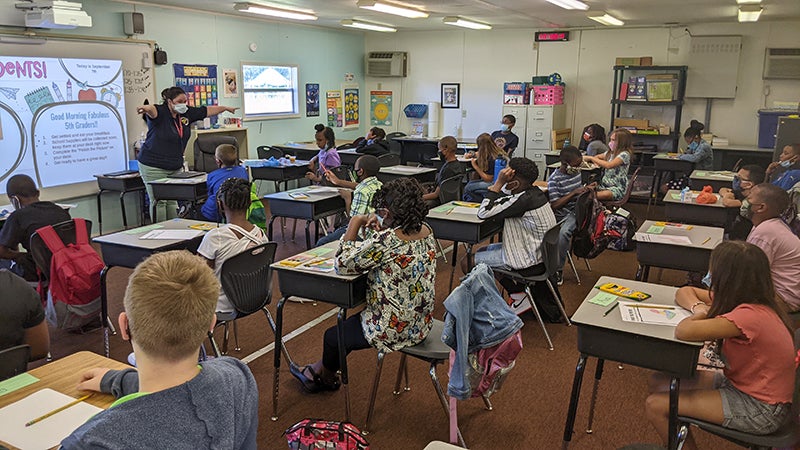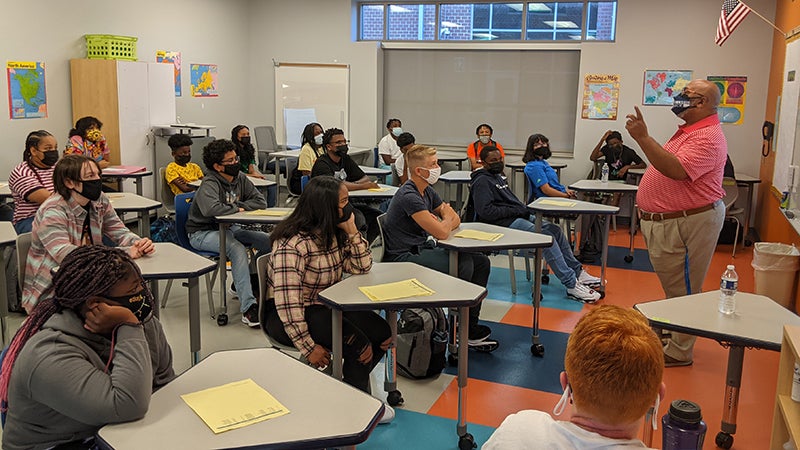With mixed emotions and masked faces, students return
Published 7:43 pm Wednesday, September 8, 2021
|
Getting your Trinity Audio player ready...
|
Though they had a mixed range of emotions about being back in school, for the first time since March 2020, the vast majority of Suffolk Public Schools’ more than 14,000 masked students returned to classrooms for the start of school.
While thousands of students returned for hybrid learning last spring, for many, it was the first time at school in 18 months.
Lines of cars snaked around buildings and buses criss-crossed the city during the morning Sept. 7 getting students to school, where they were greeted with grab-and-go breakfasts and the excited voices of teachers and staff.
New King’s Fork Middle School principal Darrell Medley said he tallied more than 500 students who were dropped off there, while at Col. Fred Cherry Middle School, another new principal, Dr. Jamel Gibson, reported a relatively smooth start to the day.
Gibson was still getting oriented to the school. “We’re going to be new together,” he said to a staff member.
With Superintendent Dr. John B. Gordon III alongside, Gibson introduced himself to classes of students, including Wendell Foster’s eighth-graders. There, Foster was demonstrating proper mask-wearing and orienting them to a new routine. Gibson wanted to let students know they could come to him if needed, and that they would see him in their classes on a regular basis.
“If you need anything from me this year, … I’m Dr. Gibson,” he said. “I’m going to be out and about all the time, probably in your rooms a lot, just talking with you, just seeing what you’re learning, but not just what you’re learning, but some of the things you might be having some challenges with, even if they’re some things at home that you’ve got to have help (to) work through, so on and so forth.
“I want you guys to know I’m not the doom and gloom guy,” Gibson continued. “I’m the checking-on-you guy. That’s what I want to do. I want to make sure that you’re learning.”
At Nansemond Parkway Elementary School, the car line circled around the parking lot and onto the road in front of the school as staff worked to match students to their rides.
New Principal Janet Wright-Davis, along with other school staff members, walked children to class while navigating the start of the school day. In different classrooms, children were eating their grab-and-go breakfast and drinking their milk as teachers began introducing themselves and outlining the routines for each class.
At Elephant’s Fork Elementary School, several buses were caught in a lengthy line that looped through the school, down William Reid Drive and onto State Route 10 to the bridge over U.S. Route 58.
Inside, Principal Dana Cherry Bilby was walking students to class, and in other classrooms, students got an introduction to the routine of being in school again.
In Ashley Nettles’ fifth-grade class, inside one of the school’s trailers, she was in the process of getting her students to stand in a semi-circle around the class.
“We’re going to try to keep our distance. … We’re going to keep that three feet distance. If you’re more comfortable at your seat, I would still love you to participate, but I understand.”
Gentle guidance in establishing the new, masked routine was the order of the day, but school division staff spent considerable time planning for a mid-pandemic school year knowing there will at least be some disruptions with high community spread, with the city’s 7-day positivity at 18.4% as of Sept. 4 and averaging 301.8 new cases per 100,000 people in the last 7 days.
The division, with 12 COVID-19 cases — one case does not equal one person and can include one person at multiple locations in the division — had its most cases in about four months. Seven of those were at Nansemond River during a week in which its football game against Great Bridge was canceled due to COVID-19. Another football game between King’s Fork High School and Indian River was canceled for the same reason.
First, above all else, Gordon said the emphasis is on keeping students and staff members safe.
“The safety protocols are our first priority,” Gordon said. “It’s always (about) keeping kids safe and teaching them, is the order.”
He said the division’s Educate and Innovate hybrid learning model it implemented in the spring was a “test run” of its safety protocols.
“We can expect for there to be COVID cases,” Gordon said. “I mean, there’s nothing we can really do about that. But it’s going to be our goal to not have any outbreaks that lead to classrooms being closed down, schools being closed down, et cetera.
“I think that’s what we’re really focused on because we want to make sure that our kids and our staff, that we’re going to have 180 days of face-to-face instruction for those who made that choice.”
When COVID-19 cases happen in the school division, Gordon said there would still be a full quarantine, though it would be less than 14 days if fully vaccinated and not showing symptoms.
“That 14 days is something that we’re going to continue, especially with the high rates that we have in the city of Suffolk right now,” Gordon said.
Everyone inside a school building must wear a mask unless eating. Students in physical education classes must wear a mask indoors but are allowed to take them off if they are outside. They will also be given mask breaks.
The division is also limiting visitors to the lobby or main office of schools, and will, for now, not allow volunteers inside. It’s all in an effort to limit COVID-19 spreading in schools.
Individual schools are putting in different measures to spread students out, such as adding extra class sections to limit class size, adding extra lunch waves to have smaller groups of students enter the cafeteria for lunch and having some of them eat in classrooms, or, for some high school students, outside. With breakfast and lunch free for all students, schools are also putting in place a lot of grab-and-go items to limit how much time people are around each other.
“The fewer people that our kids and staff come into contact with, the greater chance that we have to reach that goal,” Gordon said.
It will be a challenge in some instances to keep students spaced at least three feet apart. One class at Col. Fred Cherry, for instance, had 29 students, with a student at every desk in the room.
At King’s Fork High School, large groups of students, nearly all masked, could be seen moving close together between classes. And with enrollments there and at Nansemond River at or above 1,700 students, it will likely make three feet of separation a challenge at times.
Division officials continue to encourage people to get vaccinated against COVID-19, and will continue to enforce wearing a mask inside schools while trying to encourage social distancing and washing hands. It is working to schedule booster shots sometime in the fall.
“We know that the mask-wearing really helps us,” Gordon said. “There’s a 70% more effective rate than not wearing a mask. So that’s what we’re going to try to do while still trying to give the kids some sense of normalcy and doing as many of the same activities that we can.”
The school division has also spent $1.5 million to use bipolar ionization technology in all 21 of its buildings’ HVAC systems. He said the division’s custodians are continuing to implement a regular disinfecting schedule and tracking when they are coming into buildings. It is also limiting bathroom use to help with contact tracing.
“There was a lot of anxiety coming back last year and, and of course, there’s still some this year,” Gordon said, “but we have dedicated staff members, and I’m really believing that our staff’s going to rise to the top and meet our expectations.”
As there has been a higher rate of COVID-19 in the community in the past two months, interest in a virtual learning option has increased. Currently, the division has about 400 students in virtual learning, and more on a waiting list.
“We’ll try to accommodate them as soon as we have the ability to,” Gordon said, noting other factors that may limit how many more students it can accommodate.
But while the division found children could do well with literacy in virtual learning, it was not the same for math and science.
“Subjects like math and science, they really need that hands-on opportunity,” Gordon said.
On day one, that’s what Col. Fred Cherry life science teacher Jennifer Patgorski stresses to students — they will get to do some kind of hands-on learning in every class.
The division is also looking at accelerated learning, a way to keep moving with new concepts while trying to recover things they might not have learned in the previous grade in virtual learning. It has plans for Saturday school options starting in October.
“We’re going to do whatever we can to give our kids as much support, enrichment and remediation as possible,” Gordon said.
Having seen higher rates of virus transmission in other school divisions, Gordon is keen on wanting people to understand what it will take to keep schools open for in-person instruction. He said it has desk dividers that it can use if needed, and the division is looking at other accommodations for students in special circumstances. He said it was by following the division’s plan that it did not have any outbreaks last year when students returned to school in the spring.
Though students in several schools gave mixed reactions on how they felt about being in class again when asked, teachers and other staff worked to encourage them.
The division’s roughly 2,300 employees, Gordon said, are ready to work, and he called for 100% effort from students over the next 180 days of school as they navigate student and staff anxieties while — as it said on the door of a class at King’s Fork Middle — it’s time to “restart reimagining our potential.” But everyone, he said, has to buy in, and that starts with the measures to keep everyone safe and healthy.
“If you really want your kids to be face-to-face, you’ve got to follow our safety plan,” Gordon said. “I mean, there is no cutting corners. There is no, ‘well, my rights are being violated.’ I don’t really have a lot of patience for that because you’ve got to think more about other students. It’s not just about your kid. … It would be the same way if another kid affected your kid.”














